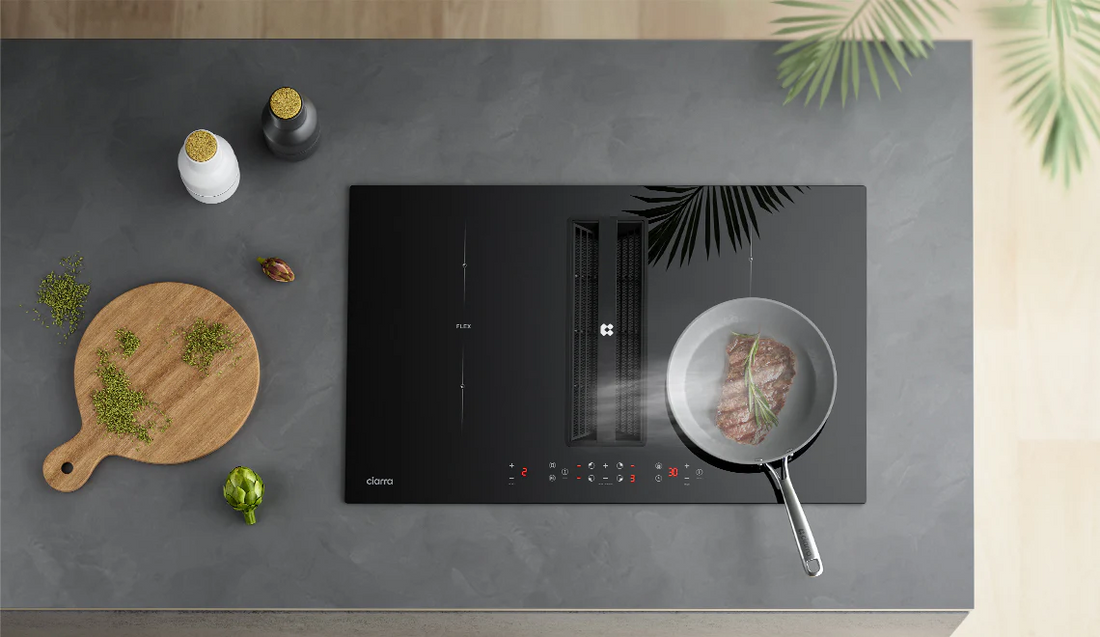Selecting the ideal downdraft induction hob for your kitchen involves assessing several key factors to ensure it aligns with your cooking needs and preferences. Here are the critical considerations to bear in mind:

Size and Cooking Zones:
Cooktop Size: Determine the size of the downdraft induction hob that fits your kitchen space. Consider the available countertop area and the hob's dimensions. Downdraft hobs come in various sizes, so choose one that complements your kitchen layout without overcrowding it.
Number of Cooking Zones: Evaluate how many cooking zones or elements you require. Downdraft induction hobs come with multiple cooking zones, typically ranging from two to five or more. Select a hob with the right number of zones to accommodate your usual cooking tasks and the size of your cookware.
Power and Heat Settings:
Power Levels: Examine the hob's power levels and heat settings. Different models offer varying power outputs, affecting how quickly the hob heats up and cooks food. Opt for a hob with a range of power levels that suit your cooking style, from gentle simmering to high-heat searing.
Booster Function: Some hobs include a booster function, providing an extra burst of heat for rapid boiling or intense searing. If you value speed in your cooking, a hob with a booster function can be a valuable addition.
Additional Features and Technologies:
Touch Controls: Consider the control interface. Many downdraft hobs feature touch controls for intuitive and precise operation. Check if the controls are responsive and user-friendly.
Safety Features: Assess the safety features offered by the hob. Look for child safety locks, overheat protection, and automatic shut-off functions to ensure a secure cooking experience.
Bridge Zones: Some models offer bridge zones or flex zones, allowing you to combine two adjacent cooking zones into a larger one. This feature is useful for accommodating larger cookware or griddles.
Cooking Sensors: Advanced hobs may come equipped with cooking sensors that detect the size and placement of your cookware, automatically adjusting the heat accordingly for optimal cooking results.
Timer and Delay Start: Check if the hob has a built-in timer and delay start function, which can be convenient for multitasking and precise meal planning.
Wi-Fi Connectivity: In some high-tech models, Wi-Fi connectivity enables remote control and monitoring through smartphone apps, providing added convenience and flexibility.
By carefully considering these factors, you can select a downdraft induction hob that perfectly suits your cooking requirements, ensuring efficient and enjoyable culinary experiences in your kitchen.
Maintenance and Cleaning of Downdraft Induction Hobs
Maintaining and cleaning your downdraft induction hob is essential to ensure its longevity, optimal performance, and a hygienic cooking environment. Proper care involves attention to the induction cooktop, the ventilation system, and filter replacement. Let's explore the steps for each of these aspects:
Cleaning Induction Cooktops:
Regular Cleaning: Wipe down the induction cooktop after each use with a damp, soapy cloth or a recommended induction cooktop cleaner. This prevents food residue and spills from hardening onto the surface.
Stubborn Stains: For stubborn stains or burnt-on residues, use a specialized induction scraper or a non-abrasive cleaning pad. Be gentle to avoid scratching the glass surface.
Avoid Abrasive Materials: Do not use abrasive scouring pads, steel wool, or harsh chemicals, as they can damage the glass surface.
Cleaning the Ventilation System:
Exterior Cleaning: Clean the exterior surfaces of the ventilation system regularly with a damp cloth and mild detergent. Ensure that the controls and buttons are kept clean and free from grease.
Internal Cleaning: Periodically inspect the interior components of the ventilation system. Remove any accumulated debris or grease build-up. Some downdraft hobs have easily accessible parts for cleaning, while others may require professional maintenance. Refer to the manufacturer's instructions for guidance.
Filter Replacement and Maintenance:
Filter Inspection: Check the filters in the ventilation system regularly. Grease and particle filters can become clogged over time, affecting the efficiency of the ventilation. If you notice a decrease in performance or increased noise, it may be time to inspect the filters.
Filter Cleaning: Many downdraft hobs have removable and washable filters. Follow the manufacturer's guidelines for cleaning these filters. Typically, they can be soaked in warm, soapy water, rinsed thoroughly, and allowed to dry before reinstallation.
Filter Replacement: Depending on your cooking habits and the type of filter used, you may need to replace filters periodically. Refer to the manufacturer's recommendations for the appropriate filter replacement schedule. Replacement filters are usually available from the manufacturer or authorized dealers.
By adhering to these maintenance and cleaning practices, you can ensure that your downdraft induction hob continues to operate efficiently and maintains a clean and hygienic cooking environment. Regular care not only extends the lifespan of your appliance but also enhances the overall cooking experience in your kitchen.

